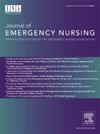COVID-19 患者插管诊断和死亡率预警评分工具的性能特征比较。
IF 1.8
4区 医学
Q2 EMERGENCY MEDICINE
引用次数: 0
摘要
简介预警评分是预测患者不良事件的重要工具。本研究旨在比较国家预警评分、汉密尔顿预警评分、标准化预警评分和分诊预警评分在预测 2019 年冠状病毒疾病患者插管和死亡率方面的诊断性能:这项预测相关性研究纳入了 2021 年 12 月至 2022 年 3 月期间伊朗内沙布尔 22 Bahman 医院急诊科收治的 370 名患者。在患者入院时和整个 1 个月的住院期间,每天对上述评分以及插管和死亡率进行评估。数据分析使用 SPSS 26 和 MEDCALC 20.0.13 软件。我们遵守诊断准确性研究报告标准指南,以确保研究报告的准确性:患者的平均年龄为 65.03 ± 18.47 岁,其中男性 209 人(56.5%)。标准化早期预警评分和汉密尔顿早期预警评分均显示出较高的诊断性能,曲线下面积值分别为 0.92 和 0.95。就标准化预警评分而言,插管的正似然比为 10.81,死亡率为 17.90;而就汉密尔顿预警评分而言,插管的正似然比为 7.88,死亡率为 10.40。在插管事件和死亡率发生前的 24 小时内,标准化预警评分的负似然比值分别为 0.23 和 0.17,汉密尔顿预警评分的负似然比值分别为 0.21 和 0.18:讨论:研究结果表明,在预测2019年冠状病毒疾病患者发生插管和死亡事件前24小时内的诊断结果时,标准化预警评分(Standardized Early Warning Score)优于汉密尔顿预警评分(Hamilton Early Warning Score)。因此,连续评估汉密尔顿早期预警评分或标准化早期预警评分可能是医护人员识别需要插管或死亡风险增加的2019年冠状病毒病高风险患者的宝贵工具。本文章由计算机程序翻译,如有差异,请以英文原文为准。
Comparison of Performance Characteristics in Early Warning Scoring Tools for Diagnosis of Intubation and Mortality Among COVID-19 Patients
Introduction
Early warning scores serve as valuable tools for predicting adverse events in patients. This study aimed to compare the diagnostic performance of National Early Warning Score, Hamilton Early Warning Score, Standardized Early Warning Score, and Triage Early Warning Score in forecasting intubation and mortality among patients with coronavirus disease 2019.
Methods
This predictive correlation study included 370 patients admitted to the emergency department of 22 Bahman Hospital in Neyshabur, Iran, from December 2021 to March 2022. The aforementioned scores were assessed daily upon patient admission and throughout a 1-month hospitalization period, alongside intubation and mortality occurrences. Data analysis used SPSS 26 and MEDCALC 20.0.13 software. We adhered to the Standards for Reporting of Diagnostic Accuracy Studies guidelines to ensure the accurate reporting of our study.
Results
The patients’ mean age was 65.03 ± 18.47 years, with 209 (56.5%) being male. Both Standardized Early Warning Score and Hamilton Early Warning Score demonstrated high diagnostic performance, with area under the curve values of 0.92 and 0.95, respectively. For Standardized Early Warning Score, the positive likelihood ratio was 10.81 for intubation and 17.90 for mortality, whereas for Hamilton Early Warning Score, the positive likelihood ratio was 7.88 for intubation and 10.40 for mortality. The negative likelihood ratio values were 0.23 and 0.17 for Standardized Early Warning Score and 0.21 and 0.18 for Hamilton Early Warning Score, respectively, for the 24-hour period preceding intubation events and mortality.
Discussion
Findings suggest that Standardized Early Warning Score, followed by Hamilton Early Warning Score, has superior diagnostic performance in predicting intubation and mortality in patients with coronavirus disease 2019 within 24 hours before these outcomes. Therefore, serial assessments of Hamilton Early Warning Score or Standardized Early Warning Score may be valuable tools for health care providers in identifying high-risk patients with coronavirus disease 2019 who require intubation or are at increased risk of mortality.
求助全文
通过发布文献求助,成功后即可免费获取论文全文。
去求助
来源期刊
CiteScore
3.10
自引率
11.80%
发文量
132
审稿时长
46 days
期刊介绍:
The Journal of Emergency Nursing, the official journal of the Emergency Nurses Association (ENA), is committed to the dissemination of high quality, peer-reviewed manuscripts relevant to all areas of emergency nursing practice across the lifespan. Journal content includes clinical topics, integrative or systematic literature reviews, research, and practice improvement initiatives that provide emergency nurses globally with implications for translation of new knowledge into practice.
The Journal also includes focused sections such as case studies, pharmacology/toxicology, injury prevention, trauma, triage, quality and safety, pediatrics and geriatrics.
The Journal aims to mirror the goal of ENA to promote: community, governance and leadership, knowledge, quality and safety, and advocacy.

 求助内容:
求助内容: 应助结果提醒方式:
应助结果提醒方式:


